

Stamina - the unwelcome word in rugby training
Steve Johnson explains six stamina and skill-based rugby training activities.
Stamina work is something that most players love to hate, and finding an effective way to develop stamina, one that the players will accept and do willingly (happily is not the best adjective), is a vital area of the coach's job. When we broached the subject at my club last year and talked about the need for running, our captain growled, "I did not join the rugby team to do track and field!" Other players nodded, and the search for hard-working, yet rugby-based, stamina activities began. The key element is the players' willingness to participate with a positive frame of mind and a desire to see the task through to the end.
How much do you move in games?
Accepted research indicates that the amount of actual playing time has, in recent years, risen to about one-third of the total game time. So, in an eighty-minute game, we should be looking for between twenty-five and twenty-six minutes of full-time activity, undertaken at top speed and full power. The target, therefore, is to create/build a series of activities in which the players would be active for a certain period, and the rest/recovery time would be doubled. For example, a one-minute activity would be followed by a two-minute recovery period. Few plays last that long, though, so we focused on a thirty-second activity followed by one minute for recovery.
What skills can we include in a stamina-based programme?
All skills can be practiced in a stamina-based activity, but the key point here is that we are not coaching/developing the skill itself, although I do not think one ever stops doing that. We are providing a situation in which there is a more than fair chance of success, so that the stamina aspect can be fully completed. In a passing activity, for example, we play touch (not tackle) so that the runners can carry on running.
The stamina-related aspects of play we work on are:
- Passing and running play
- Contact work
- Defence
In the contact work, we want the players to keep going, so we use contact shields. Whenever we can, we use arm-free contact shields such as the RadPads advertised in the Technical Journal a couple of years ago. Defence stamina-related work is undertaken with tackle bags and shields. It is the running to get into defensive positions that we are working on, rather than the tackle itself, although we do keep an eye on the correct technique. If it is not right, we will pull the player out after the stamina session is over and go through the weak point again.
Run/pass play. Activity 1
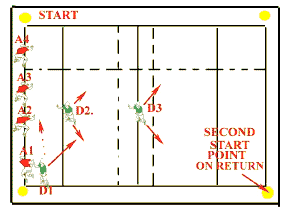 Assemble the players in speed groups in fifteen metre-wide zones
that go from one goal line to the other. Depending on numbers, this activity
can be done in sixes, sevens, and, in extremis, eighths.
Assemble the players in speed groups in fifteen metre-wide zones
that go from one goal line to the other. Depending on numbers, this activity
can be done in sixes, sevens, and, in extremis, eighths.
There are four attackers positioned about ten metres from the goal line (one is a scrum-half who is about fifteen metres out). The best number of defenders is three. If there are six in a group, have four attackers and two defenders; seven, four, and three; eight, five, and three. The first defender is a 'flanker', who taps the scrum-half when the activity starts and then runs a covering course backwards to pressure the attacking players. The second defender starts on the halfway line, and the third defender is on the far twenty-two-metre line.
The attackers' job is to score without:
- being touched in possession by any of the defenders
- throwing forward
- knocking on
Flanker(s) and defenders chase back all the way, trying to defend their line. Failure by the attackers can be greeted with great hilarity by the defenders, and the attackers have to either:
- run back to the original goal line and sprint the whole 100 metres
- sprint to the target goal line in preparation to start the next time
This depends on the ability of your players, and only you can be the judge. As a guide, I make the top team run back to the start goal line, and the lower-level players do not have to.
Timing
Ball travelling time. If you assume that the longest time it will take the ball to get from start to goal is 30 seconds, start the second and each consecutive run after 90 seconds (60 seconds recovery). That is slow, though, and you should soon see your team going at 20 to 25 seconds with a 40 to 50 second recovery time. Each attack group goes out and back, then attackers/defenders change. You can put more than one group in the channel and start them every 15 seconds.
Number of repetitions
You set several rotations, and one rotation works like this: (7 player group)
| Attack | Defence | (Note) | |
| 1st run | 1,2,3,4 | 5,6,7 | The number of runs in one rotation equals the number of players. |
| 2nd run | 5,6,7,1 | 2,3,4 | |
| 3rd run | 2,3,4,5 | 6,7,1 | |
| 4th run | 6,7,1,2 | 3,4,5 | Another great point about this activity is its shortness. This set of 7 runs would only take 9 minutes. |
| 5th run | 3,4,5,6 | 7,1,2 | |
| 6th run | 7,1,2,3 | 4,5,6 | |
| 7th run | 4,5,6,7 | 1,2,3 |
If this type of activity is new, start with just one rotation and, as players' stamina improves, add more rotations. My team usually does 3 sets, which is 21 runs.
Front row variation
For front-row forwards, especially heavy props (and even for heavy, less mobile locks), the activity goes from goal line to halfway line with a 30-second recovery period. This is not to disparage the front row, but research indicates that in a game, the stoppage time for front forwards is about 30 to 45 seconds. So, a shorter run and shorter recovery period are appropriate. Of course, the number of rotations is double that of your long-distance group.
Comment
This is hard, but it is very enjoyable, I promise! I maintain that this activity is real rugby, and it is the players' chance to play the game. I have never had a group that has been unhappy with this stamina activity.
Run/pass play stamina activity 2 - 6 versus 3 and 3
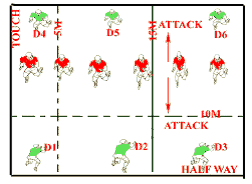 The playing area is 30m wide and 22m long. This activity is good
for stamina and also gives players a lot of opportunities to work on their
passing, catching, and angles of running in short bursts. As shown in the
diagram, six attackers alternately attack defenders 1, 2, and 3, then 4, 5, and
6.
The playing area is 30m wide and 22m long. This activity is good
for stamina and also gives players a lot of opportunities to work on their
passing, catching, and angles of running in short bursts. As shown in the
diagram, six attackers alternately attack defenders 1, 2, and 3, then 4, 5, and
6.
They attack for one minute. Defenders can come forward to pressure the attackers, but when the attack on their goal line is over, they must retreat to the goal line until the next wave of attack comes to them. After 60 seconds, teams have 10 seconds to take up new attack/defence positions, and the whistle goes for the next attack to start.
Number of repetitions
I suggest five times per team for the first session, and see how they go. This can be increased as appropriate. My team usually asks me to set it for about ten runs per team (20 minutes in total), but we have done 15 runs each; only you can decide what the correct load is.
Competitive element
The losing team has to piggyback the winning team to the goal line, but the coach can make up anything.
Contact play stamina activities
Activity 1: 3 versus 2
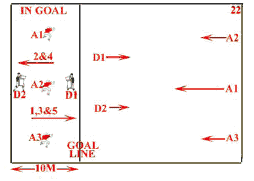 Three attacking players in the first group start in the in-goal area.
One shield-holding defender (the best shield is the arms-free type) is on the goal
line (D1), and another (D2) is 10 metres into the in-goal area. Attacker 1 hits the
shield (D1) on the goal line, 2 calls the ruck ball he wants, and cleans out the
shield. 3 takes the ball and returns to D2, where he hits. 1 calls the ruck
ball, 2 picks, and goes back to D1. After 5 reps, they run to the 22m line. D1
and D2 prepare to defend the goal line, the ball-carrying attacker takes a
quick penalty, and the attackers try to score using any method they can (pass
play/maul, etc.).
Three attacking players in the first group start in the in-goal area.
One shield-holding defender (the best shield is the arms-free type) is on the goal
line (D1), and another (D2) is 10 metres into the in-goal area. Attacker 1 hits the
shield (D1) on the goal line, 2 calls the ruck ball he wants, and cleans out the
shield. 3 takes the ball and returns to D2, where he hits. 1 calls the ruck
ball, 2 picks, and goes back to D1. After 5 reps, they run to the 22m line. D1
and D2 prepare to defend the goal line, the ball-carrying attacker takes a
quick penalty, and the attackers try to score using any method they can (pass
play/maul, etc.).
The activity should take 30-35 seconds, and Group 2 starts immediately afterwards. Group 1 changes attackers and defenders, and as soon as Group 2 has finished, they go. With five players, there are 5 rotations for one set (attack 123 then 451, 234, 512, 345) - about 10 minutes for one set of 2 groups. The coach can decide the number of sets.
Activity 2: 3 versus 3
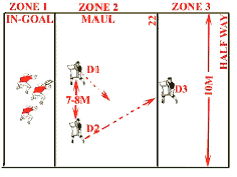 3 attackers alternately ruck out shield-holding D1 and D2 for 20 seconds. "In-Goal" is a good point to start. On the 20-second whistle, the
'free' defender runs into a deeper defensive position, and the attackers maul
him to the 22m line. At the same time, the other defender drops his shield and
runs to the 22m line, where he joins the 3rd defender. When the attackers reach
the 22m line, they roll off the shield and play a 3 versus 2 to score on the
halfway line. When they reach the halfway line, they jog back to the goal
line and prepare for the next run when attack and defence roles are
changed.
3 attackers alternately ruck out shield-holding D1 and D2 for 20 seconds. "In-Goal" is a good point to start. On the 20-second whistle, the
'free' defender runs into a deeper defensive position, and the attackers maul
him to the 22m line. At the same time, the other defender drops his shield and
runs to the 22m line, where he joins the 3rd defender. When the attackers reach
the 22m line, they roll off the shield and play a 3 versus 2 to score on the
halfway line. When they reach the halfway line, they jog back to the goal
line and prepare for the next run when attack and defence roles are
changed.
If you make 3 groups of 6, they will be pretty busy. We like this as one of our warm-up activities, and we do about 5 rotations.
Defence-based stamina activities
Activity 1: Continuous "through the gate" tackles
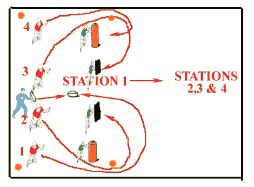 As shown in the diagram, there are 4 defenders. There are 4 people
at each station, and the number of tackles you can perform will depend on the
number of players and tackle bags available. The coach is the opposition scrum-half.
As shown in the diagram, there are 4 defenders. There are 4 people
at each station, and the number of tackles you can perform will depend on the
number of players and tackle bags available. The coach is the opposition scrum-half.
On a dummy pass from the coach, the players break to the cones, and then they go as quickly as possible back to station 1. The lead defender, T1 (tackler 1), goes through 'the gate' (around the marker) and dives on the ball. T2 and T3 clean out the 2 shield holders. T4 is the next defence leader, and he calls T1 into position. When the coach does a dummy pass, T1 and T4 hit the tackle bags. All 4 then run back to the next station and repeat, continuing until station 4.
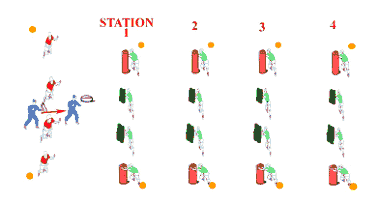 Rotations
Rotations
Depends on numbers. If you have 20 players, you can rotate so that the players go from tackle to holding the equipment at station 4, then 3, 2, and 1 before becoming tacklers again. From a stamina point of view, 32 players are ideal. With this number, 16 tacklers and 16 equipment holders go several times or for a set time, but how often can we arrange that? We have 52 players, and we can usually put 24 on this activity (3 stations) and 24 on activity 2 (following drill).
Defence Activity 2
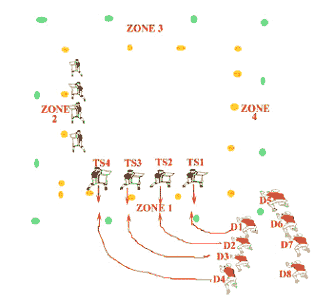 Use cones to make an inner and outer square. The inner square should
be wide enough for 4 shield holders to take tackles and go back in safety
(about 12m). The outer square should be about 1.5 metres wider. 4 shield
holders are in zone 1, and another 4 shield holders are in zone 2. On the
signal, D1 to 4 run into zone 1 and line up in front of the shield holders. On
the signal, they advance and hit the shields in a medium-high tackle (chest
hit, with one hand lifting the leg). Drive for 1 to 2 seconds, release, and
quickly run into zone 2, where the same activity is performed against shield
holders 5 to 8. As soon as tackle shield holders 1 to 4 have been released,
they run across the area to the inside of zone 3. When tackle shield holders 5
to 8 are released, they run across to zone 4, and so on.
Use cones to make an inner and outer square. The inner square should
be wide enough for 4 shield holders to take tackles and go back in safety
(about 12m). The outer square should be about 1.5 metres wider. 4 shield
holders are in zone 1, and another 4 shield holders are in zone 2. On the
signal, D1 to 4 run into zone 1 and line up in front of the shield holders. On
the signal, they advance and hit the shields in a medium-high tackle (chest
hit, with one hand lifting the leg). Drive for 1 to 2 seconds, release, and
quickly run into zone 2, where the same activity is performed against shield
holders 5 to 8. As soon as tackle shield holders 1 to 4 have been released,
they run across the area to the inside of zone 3. When tackle shield holders 5
to 8 are released, they run across to zone 4, and so on.
Points awarded
When the tackler drives the tackle shield holder back across the inner line, he gets the point. If the tackle shield holder drives the tackler back across the outer line, he gets the point. This competitive aspect raises the adrenaline levels quite significantly (!), and you will need a couple of referees on this to avoid injuries. We do this for 10 minutes per team and, typically, the scores are in the region of 180 to 178. The losing team has to piggyback the winners to the goal line.
If we have two injured players who cannot tackle but can run, they act as the half-backs (this is pretty hard too), and on the pass, the tacklers break. If there are no passers, then the coach can be in the middle, and when he sees that all four tacklers have arrived, he can call "break" or "up", or whatever your team's signal may be.
There you have six stamina-based activities that are fun, yet potentially hard work. I suppose the ultimate stamina activity is one where the players do not think they are doing stamina work at all, and I believe that these activities come pretty close to achieving that.
Article Reference
This article first appeared in:
- JOHNSON, S. (2006) Stamina - the unwelcome word in rugby training. Brian Mackenzie's Successful Coaching, (ISSN 1745-7513/ 36/ October), p. 5-6
Page Reference
If you quote information from this page in your work, then the reference for this page is:
- JOHNSON, S. (2006) Stamina - the unwelcome word in rugby training [WWW] Available from: https://www.brianmac.co.uk/articles/scni36a4.htm [Accessed
About the Author
Steve Johnson is a Rugby Football Union Level 3 coach who has been coaching for over 20 years. In 1997, he went to Japan, where he currently coaches a high school team and regional teams.